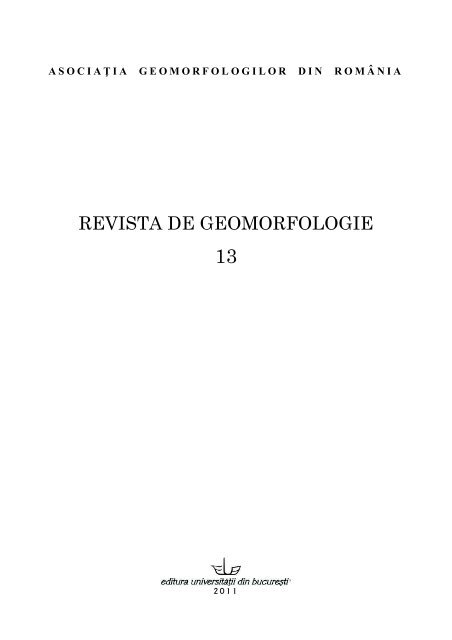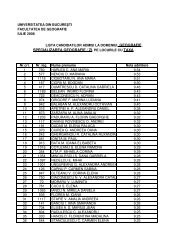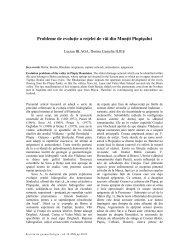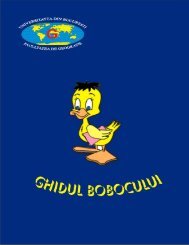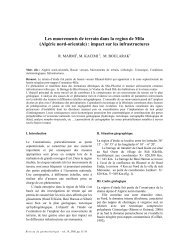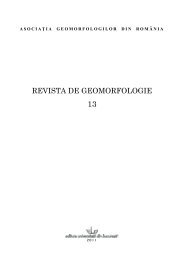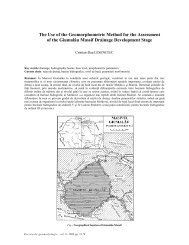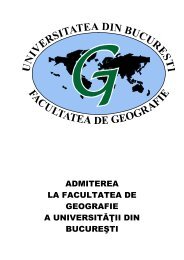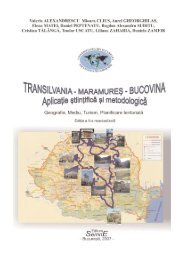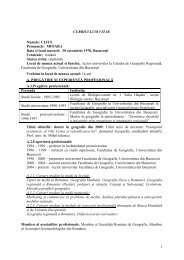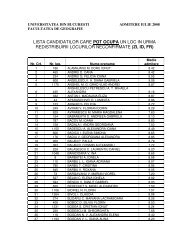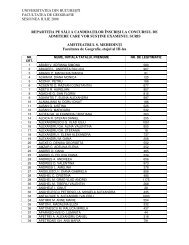Florina GRECU, Cristina GHIŢĂ, Emil CÎRCIUMARU
Florina GRECU, Cristina GHIŢĂ, Emil CÎRCIUMARU
Florina GRECU, Cristina GHIŢĂ, Emil CÎRCIUMARU
Create successful ePaper yourself
Turn your PDF publications into a flip-book with our unique Google optimized e-Paper software.
A S O C I A Ț I A G E O M O R F O L O G I L O R D I N R O M Â N I A<br />
REVISTA DE GEOMORFOLOGIE<br />
13<br />
2 0 1 1
REVISTA DE GEOMORFOLOGIE / REVIEW OF GEOMORPHOLOGIE<br />
Editori/Editors: Prof. univ. dr. Virgil SURDEANU – Preşedintele A.G.R., Universitatea „Babeş-Bolyai”, Cluj Napoca<br />
Prof. univ. dr. <strong>Florina</strong> <strong>GRECU</strong>, Universitatea din Bucureşti<br />
Colegiul de redacție/Editorial boards:<br />
Dr. Lucian BADEA, Institutul de Geografie, Bucureşti<br />
Prof. dr. Yvonne BATHIAU-QUENNEY, Universitatea din Lille, Franța<br />
Prof. dr. Dan BĂLTEANU, Universitatea din Bucureşti<br />
Prof. dr. Costică BRÂNDUŞ, Universitatea „Ştefan ce! Mare”, Suceava<br />
Prof. dr. Doriano CASTALDINI, Universitatea din Modena, Italia<br />
Prof. dr. Adrian CIOACĂ, Universitatea „Spiru Haret”, Bucureşti<br />
Prof. dr. Morgan de DAPPER, Universitatea din Gand, Belgia<br />
Prof. dr. Mihaela DINU, Universitatea Româno-Americană, Bucureşti<br />
Prof. dr. Francesco DRAMIS, Universitatea Roma 3, Roma, Italia<br />
Prof. dr. Eric FOUACHE, Universitatea Paris 12, Franța<br />
Prof. dr. Paolo Roberto FEDERICI, Universitatea din Pisa, Italia<br />
Prof. dr. Mihai GRIGORE, Universitatea din Bucureşti<br />
Prof. dr. Mihai IELENICZ, Universitatea din Bucureşti<br />
Prof. dr. Ion IONIȚĂ, Universitatea „Al.I. Cuza”, Iaşi<br />
Prof. dr. Aurel IRIMUŞ, Universitatea „Babeş-Bolyai”, CIuj-Napoca<br />
Prof. dr. Nicolae JOSAN, Universitatea din Oradea<br />
Prof. dr. Ion MAC, Universitatea „Babeş-Bolyai”, Cluj-Napoca<br />
Prof. dr. André OZER, Universitatea din Liège, Belgia<br />
Prof. dr. Kosmas PAVLOPOULOS, Universitatea din Atena, Grecia<br />
Prof. dr. Dan PETREA, Universitatea „Babeş-Bolyai”, Cluj-Napoca<br />
Prof. dr. docent Grigore POSEA, Universitatea „Spiru Haret”, Bucureşti<br />
Prof. dr. Ioan POVARĂ, Institutul de Speologie, Bucureşti<br />
Prof. dr. Maria RĂDOANE, Universitatea „Ştefan cel Mare” Suceava<br />
Prof. dr. Nicolae RĂDOANE, Universitatea „Ştefan cel Mare”, Suceava<br />
Prof. dr. Contantin RUSU, Universitatea „Al. I. Cuza”, Iaşi<br />
Dr. Maria SANDU, Institutul de Geografie, Bucureşti<br />
Prof. dr. Victor SOROCOVSCHI, Universitatea „Babeş-Bolyai”, Cluj-Napoca<br />
Prof. dr. Petre URDEA, Universitatea de Vest, Timişoara<br />
Prof. dr. <strong>Emil</strong> VESPREMEANU, Universitatea din Bucureşti<br />
Prof. dr. Fokion VOSNIAKOS, Universitatea din Salonic, Grecia<br />
Redacția tehnică/Tehnical assistants:<br />
Prof. dr. Bogdan MIHAI (Universitatea din Bucureşti)<br />
Cercet. şt. drd. Marta JURCHESCU (Institutul de Geografie al Academiei Române)<br />
Lector dr. Robert DOBRE (Universitatea din Bucureşti)<br />
Şos. Panduri, 90-92, Bucureşti – 050663; Telefon/Fax: 021.410.23.84<br />
E-mail: editura_unibuc@yahoo.com<br />
Internet: www.editura.unibuc. ro<br />
Tehnoredactare computerizată: Meri Pogonariu<br />
ISSN 1453-5068
R E V I S T A D E G E O M O R F O L O G I E<br />
VOL. 13 2011<br />
C U P R I N S / C O N T E N T S<br />
A r t i c o l e / P a p e r s
Land vulnerability to geomorphological hazard induced by pluviometric criteria (Romanian Plain). This study<br />
tries to bring a contribution to the motivation of the current geomorphological processes in terms of their genetic link<br />
with the climatic factor in general and the rainfall one in particular. One of the most esed climatic index to determine<br />
the susceptibility of land to rainfall, with real and concrete applications in dynamic geomorphology, is the Angot index.<br />
The general objective of this study is to identify first the months, seasons or years with very high or very low<br />
susceptibility to erosion phenomena production of the banks and also the values of this index during the year, in order to<br />
identify the cumulation of the pluvial conditions which could induce, in general, the modeling processes. Aplied to<br />
amounts of rainfall from Stolnici and Alexandria meteorological station for the period 1961-2000, Angot Index reveals<br />
that geomorphological processes along Vedea valley and its tributaries are largely generated by the fallen precipitation<br />
amou8nts, plus other factors (petrographic, hydrogeological, morphometric, the use of the land, etc.).<br />
Key Words: Angot Index, Romanian Plain, Vedea basin, precipitation susceptibility.<br />
Vulnerabilitatea terenurilor la hazarde geomorfologice după criteriul pluviometric (Câmpia Română). Prezentul<br />
studiu încearcă să aducă o contribuție la motivarea proceselor geomorfologice actuale prin prisma legăturii lor genetice<br />
cu factorul climatic, în general şi cel pluviometric, în special. Unul dintre cei mai folosiți indici climatici pentru<br />
determinarea susceptibilității terenului la precipitațiile atmosferice, cu reale şi concrete aplicații în geomorfologia<br />
dinamică, este indicele Angot. Obiectivul general al studiului îl constituie identificarea, pe de o parte a lunilor,<br />
sezoanelor sau anilor cu o susceptibilitate foarte ridicată sau foarte coborâtă de producere a fenomenelor de dinamică a<br />
albiilor şi torențialitate ca şi variația valorilor acestui indice în cursul anului în vederea identificării cumului de condiții<br />
pluviometrice care ar putea induce, în general, procesele de modelare. Aplicat la cantitățile de precipitații de la stațiile<br />
meteorologice Stolnici şi Alexandria, pentru perioada 1961-2000, Indicele Angot evidentiază faptul că procesele<br />
geomorfologice din lungul văii Vedea şi a afluenților acesteia (sunt generate într-o mare măsură de cantitățile de<br />
precipitații căzute, la care se adaugă şi alți factori (petrografici, hidrogeologici, morfometricei, modul de utilizare al<br />
terenurilor etc).<br />
Cuvinte cheie: Indicele Angot, Câmpia Română, Bazinul Vedea, susceptibilitate la precipitații.<br />
1. Introduction and objective<br />
In the plain area, the appearance and intensity of the<br />
contemporary geomorphological processes are<br />
controlled by geology (type of deposits, thickness,<br />
granulometry), hydrogeology (depth of water table,<br />
water-level regime, flow direction, mineralization),<br />
human interventions (dams, dykes, irrigations), and<br />
especially by the climatic factor in general and the<br />
precipitation regime in particular (Grecu et. all,<br />
2006; 2009)<br />
One of the most widely used climatic index for<br />
determining the land susceptibility to atmospheric<br />
precipitation, with real and concrete applications in<br />
dynamic geomorphology, is the Angot index.<br />
The precipitation is a major meteorological<br />
element that triggers, maintains and reactivates<br />
some geomorphological processes, thus acting as a<br />
shaping agent in the plain areas. This influence can<br />
be highlighted by quantifying the values of selected<br />
characteristic variables (duration, frequency and<br />
intensity), as well as by delimiting in time the<br />
individual and successive snapshots that present a<br />
certain degree of susceptibility (Dragota, 2006).<br />
The general objective of this study is to identify<br />
first the months, seasons or years with very high or<br />
very low susceptibility to erosion phenomena<br />
production of the banks and also the values of this<br />
index during the year, in order to identify the<br />
cumulation of the pluvial conditions which could<br />
induce, in general, the modeling processes.<br />
Revista d e geo morfol ogie vol. 13, 2011, pp. 59-66
60<br />
F l o r i n a G R E C U , C r i s t i n a G H I Ț Ă , E m i l C Î R C I U M A R U<br />
2. General Features about the Study Area<br />
The Vedea catchment lies in the central part of the<br />
Romanian Plain, where the climatic features,<br />
together with the geological and hydrogeological<br />
ones, may turn into vulnerability factors for the land<br />
(Fig. 1). In addition, the trunk river is allochthonous<br />
and it flows directly into the Danube.<br />
From the hydrogeological point of view, the<br />
northern section of the catchment is represented by<br />
the piedmontane deposits, which have a flow<br />
regime imposed by the thickness and lithological<br />
characteristics of the Candesti Strata (Grecu et. all<br />
2006, 2009). In the southern section, the presence of<br />
the Fratesti Strata (of Balcanic origin) at high<br />
depths and the specific features of the overlying<br />
loessoid deposits have imposed different<br />
underground and superficial flowing regimes<br />
(Liteanu, 1953,1969). Under the circumstances,<br />
precipitation becomes a major shaping agent for the<br />
triggering, maintaining and reactivation of the<br />
channel and slope processes.<br />
Pluviometric regime. The mean multiannual<br />
amount of precipitation specific for the Vedea<br />
catchment drops on the north-south direction, from<br />
569.3 mm at Stolnici, in the piedmont area, to 520.3<br />
mm at Alexandria (acording NMA). The maximum<br />
is recorded in August in the north (78.6.mm) and in<br />
July in the south (65.9 mm), whereas the minimum<br />
values are specific for January and February in the<br />
north (32.6 mm) and October in the south (28.2 mm).<br />
Table no. 1 Vedea drainage basin - morphometric<br />
parameters<br />
Morphometric parameters Vedea basin/river<br />
Altitude (m) max 559<br />
min 20<br />
Lenght of the river (km) 251 (200 in the plain)<br />
Width of the basin (km) 54<br />
Drainage area (km 2 ) 5266<br />
Horton-Strahler hierarcy<br />
(Horton, 1945, Strahler, 1952).<br />
7<br />
The multiannual regime emphasizes<br />
considerable departures from the mean. Thus, the<br />
highest annual amounts may reach in the rainy years<br />
more than 700 mm, both at Stolnici (1966, 1971,<br />
1972, 1979, 1980) and at Alexandria (1964, 1966,<br />
1969, 1972), whereas the lowest amounts, below<br />
400 mm, are specific for the dry years: at Stolnici in<br />
1990 and 2000 and at Alexandria in 1965, 1985,<br />
1990, 1996 and 2000.<br />
Fig. 1. Location of the Vedea drainage basin and the weather station used in the study
Land Vulnerability to Geomorphological Hazard Induced by Pluviometric Criteria (Romanian Plain)<br />
Fig. 2. Variability of annual quantities of precipitation and their trends<br />
(Stolnici and Alexandria weather station) (1961-2000)<br />
The precipitation shows a slight decreasing<br />
linear tendency both in the north and in the south.<br />
The polynomial trend line of degree six shows the<br />
following aspects: in the north the annual amounts<br />
of precipitation increased sharply from 1961 to<br />
1966 and then dropped by 200-250 mm during the<br />
periods 1966-1967 and 1979-1980; between 1970<br />
and 1972 and between 1976-1979 precipitation<br />
decreased; after 1979 until the year 2000 there was<br />
again a decrease, with a significant departure from<br />
the multiannual mean for the interval 1990-1995<br />
and for the year 2000 (Fig. 2). The highest amount<br />
of precipitation was recorded in 1966, a year when<br />
floods were frequent and water table rose.<br />
In the multi-annual regime, in 18.91% of the<br />
cases July was the wettest month of the year, while<br />
January and February were in 64.85% of the cases<br />
the driest months. Except for February, which is the<br />
driest month, all the other months of the year<br />
experienced during the investigated period<br />
maximum annual amounts, too. Thus, January was<br />
the wettest month of the year in 2.3% of the cases (a<br />
percent that is also specific for April and<br />
November), March, September and October in 4.7%<br />
of the cases, May and August in 9.3%, July in<br />
16.3% and December in 11.5% of the cases. These<br />
monthly shares of the pluviometric regime determine<br />
the maximum range of temporal variability of this<br />
meteorological parameter, which influences the<br />
occurrence rate of geomorphological processes.<br />
3. Data and Methods<br />
The analysis of the pluviometric regime in the<br />
Vedea catchment is based on the data recorded at<br />
the two weather stations in the area, namely<br />
61<br />
Stolnici, in the north of the catchment, and<br />
Alexandria, in the south. The stations are<br />
representative for the entire catchment both from<br />
the point of view of the territorial covering and<br />
from the point of view of the possibility to extend<br />
the datasets by calculation. The first station is<br />
representative for the upper section of the<br />
catchment and for most of its central part, that is for<br />
the piedmontane area and for the north of the plain.<br />
The second station is representative for the<br />
downstream part of the catchment lying entirely in<br />
the plain and drained by the Vedea and its<br />
tributaries. The Angot index values have been<br />
computed for the interval 1961 – 2000.<br />
1. The specific features of the pluviometric<br />
regimes of the Vedea catchment influence the<br />
susceptibility to the contemporary geomorphological<br />
processes. In order to highlight this, the Angot<br />
index has been used, which is computed as follows:<br />
IAngot = (q/n)/Q/365<br />
where q is the mean daily amount of precipitation<br />
for a given month; n is the number of days of the<br />
respective month (except for February, which is<br />
considered to have 28 days even in the leap years);<br />
Q is the mean multiannual amount of precipitation;<br />
and 365 is the number of days in a year (Indici şi<br />
metode cantitative utilizate în climatologie, 2003).<br />
This index shows the annual variability of<br />
precipitation and highlights the rainy (IAngot > 1) and<br />
the dry (IAngot < 1) intervals. Depending on the<br />
results, the susceptibility classes to the<br />
contemporary geomorphological processes are<br />
determined based on the amount of precipitation<br />
fallen to the ground (Table 2).<br />
Tabel no. 2 - Susceptibility classes of precipitations to reactivating geomprphological processes<br />
based on Angot Pluvial Index attributes<br />
Pluviometric attributes Very dry Dry Normal Rainy Very rainy<br />
Susceptibility classes Very low Low Moderate High Very high<br />
Angot Index value 2.50
62<br />
F l o r i n a G R E C U , C r i s t i n a G H I Ț Ă , E m i l C Î R C I U M A R U<br />
The computing formula of the Angot index has<br />
the advantage of characterizing the months of the<br />
year from the pluviometric point of view.<br />
2. Cartographic data extracted from topographical<br />
maps (scales of 1:25.000 and 1:50000), ortophotos<br />
(scales 1:5000) and thematic maps (geologica,<br />
hydrogeological, climatic)<br />
3.Climate data (precipitation) taken from<br />
different sources, mainy the Meteorological<br />
National Administration (MNA), Clima Romaniei<br />
(2008), for the weather stations in the investigation<br />
area (Alexandria, Stolnici). The analyzed periods<br />
are variable, between 1961-2006.<br />
4.Data from field observation and measurements<br />
(topographic surveys).<br />
4. Results<br />
4.1. Angot Index analysis<br />
For the Vedea catchment, the Angot index values<br />
for the northern section of the catchment (Stolnici)<br />
are more than one all year round, with a maximum<br />
in July (2.5). In the lower section, at Alexandria, the<br />
maximum is reached in July (2.19), while in<br />
October the value is less than one (0.88) (Fig. 3).<br />
This index shows that in this area of the Romanian<br />
Plain the amount of precipitation is higher than in<br />
its eastern part, where the values more than one are<br />
specific only for the interval April – September. For<br />
instance, in the Mostistea catchment the maximum<br />
value of the Angot index is 1.47 in July (Ghita &<br />
Dragota, 2010). The index also emphasizes that the<br />
driest months belong to the cold season.<br />
From the standpoint of the multiannual regime,<br />
in 83% of the cases July was the wettest month of<br />
the year, the maximum value of the Angot index<br />
reaching 6.32 in 1980. At Stolnici weather station,<br />
January, February, March and October experienced<br />
in more than 60% of the cases the lowest mean<br />
amounts of precipitation. With the exception of<br />
October, which displayed drastic water deficits in<br />
1965, 1969 and 2000, when the values dropped to<br />
zero, all the other months of the year recorded<br />
maximum annual amounts during the period 1960 –<br />
2000.<br />
At Alexandria weather station, the situation was<br />
as follows: the wettest month (June) showed values<br />
Weather<br />
station<br />
Year<br />
Pp.<br />
annual<br />
(mm)<br />
more than one in 95% of the cases, but values above<br />
2 in only 20% of the cases. The driest month of the<br />
year (October) exhibited values less than one in<br />
75% of the cases.<br />
At both weather stations, January was the<br />
wettest month of the year in 6% of the cases, a<br />
percent specific also for February and October.<br />
March, April, November and December were the<br />
wettest in 7% of the cases, and May, June, July and<br />
August in more than 10% of the cases (July 13.5%<br />
and June 12.5%). These monthly percentages<br />
determine for the study area the maximum range of<br />
temporal variability of precipitation, which in its<br />
turn influences the occurrence of geomorphological<br />
processes all year round. It is worth mentioning that<br />
despite the fact that on a multiannual scale October<br />
is the driest month, in 1972, under exceptional<br />
conditions, it displayed the highest values of the<br />
Angot index (9.2 at Stolnici and 5.61 at Alexandria).<br />
The determination of the annual pluviometric<br />
features based on the annual values (K) of the<br />
Angot index.<br />
During the interval 1961 – 2000, there was only one<br />
year (2000) when the pluvial regime did not offer<br />
favorable conditions for the triggering of the<br />
contemporary geomorphological processes. This<br />
situation was emphasized by the Angot index value,<br />
which was lower than 0.99.<br />
The driest years do not create favorable<br />
conditions for the triggering of geomorphological<br />
processes, because of the weak pluvial impact. At<br />
Stolnici station, there are 14 years when the Angot<br />
index values did not exceed 1.5. Of the previously<br />
mentioned interval, the driest year was 1992, when<br />
the Angot Pluvial Index was less than one.<br />
At Alexandria weather station, 12 years with<br />
values less than 1.2 are considered dry. These years<br />
are: 1961, 1963, 1965, 1982, 1985, 1988, 1989,<br />
1990, 1992, 1996, 1999 şi 2000. In the southern part<br />
of the catchment, the year 1985 showed Angot<br />
index values less than 1.2 for each month, while the<br />
values for 1990, 1992 and 2000 were less than one.<br />
Every year has a certain prevalence of the months<br />
with moisture deficit.<br />
Table no 3. The driest 2 years (K
Land Vulnerability to Geomorphological Hazard Induced by Pluviometric Criteria (Romanian Plain)<br />
Fig. 3. Variation of monthly rainfall index Angot - Vedea catchment (1961-2000)<br />
At Stolnici station, the situation is the<br />
following: in the 14 years considered dry, the<br />
months with pluviometric deficit vary between 7<br />
and 10 cases (a frequency of 58% and 83%<br />
respectively). For Alexandria weather station, the<br />
number of dry months ranges from 8 to 12, that is<br />
from 67% to 100%. The prevailing dry months with<br />
Angot index values less than 1.5 occur frequently<br />
during the periods January – April and September –<br />
December. In the case of the dry years, the rainy<br />
months differ in the north in comparison with the<br />
south of the catchment. At Stolnici station, the<br />
frequency of the months with pluviometric surplus<br />
varies between 2 and 5 (25% and 42% respectively)<br />
and the occurrence intervals are May – August and,<br />
rarely, December. At Alexandria, the number of<br />
rainy months of the dry years is between 0 and 4,<br />
that is a frequency of 0 and 33%.<br />
By contrast, the Angot index values have<br />
allowed the separation of some rainy years, when K<br />
was greater than 2, which means the respective<br />
years had a high susceptibility of the landscape to<br />
the pluvial factor (table 4). The Stolnici station<br />
lying in the north of the catchment has a long series<br />
of years when the land was exposed to the pluvial<br />
factor, as follows: 1966, 1971, 1972, 1979 and<br />
1980. As far as Alexandria station is concerned, the<br />
datasets include only three rainy years, namely 1966<br />
(July – 128.8 mm), 1969 (June – 165.8 mm) and<br />
1972 (July – 114.5 mm) (according to Dragota,<br />
2006 and Clima Romaniei, 2008). One should note<br />
that for both weather stations 1966 and 1972 were<br />
very wet years (table 4), which demonstrates that<br />
precipitation regime was the same over the entire<br />
Vedea catchment.<br />
In the north, at Stolnici weather station, only<br />
four months in 1972 (May, August, September and<br />
October) exceeded the index value of 2 units,<br />
whereas in the south, at Alexandria, only five<br />
months were wet (May, July, August, September<br />
and October). For both weather stations, the highest<br />
63<br />
Angot index values were recorded in October 1972<br />
(9.2 at Stolnici and 5.61 at Alexandria), which<br />
explains the high floods that plagued that year. At<br />
Stolnici station, in the five years designated as<br />
having a maximum susceptibility to precipitation<br />
the rainy months ranged from 4 to 8, that is between<br />
33% and 67% of the year. Generally, the<br />
precipitation fell during the warm season, with the<br />
exception of 1966 and 1980 when the wettest<br />
months occurred in the cold season. At Alexandria,<br />
the number of rainy months in the three years<br />
considered very susceptible to the pluvial factor was<br />
between 5 and 6, that is 42% to 50% of the year. A<br />
special situation occurred in 1966, when most of the<br />
months having an Angot index greater than 2<br />
belonged to the cold season.<br />
On a monthly scale, of the 960 possible cases<br />
(the total number of months in the 37 investigated<br />
years) the highest frequency (40%) is hold by the<br />
very low susceptibility class, followed by the low<br />
susceptibility one (18%). In 159 cases (3.15%) the<br />
land susceptibility to contemporary geomorphological<br />
processes was very high.<br />
In the cold semester, the very low and low<br />
susceptibility values are prevalent, while the<br />
relative frequencies of the high and very high<br />
classes are low.<br />
In the warm semester, the very high and high<br />
susceptibility classes prevail, but the medium class<br />
has a significant relative frequency.<br />
4.2. Vulnerability<br />
In order to get a comprehensive picture of the<br />
degree of influence of the amount of precipitation<br />
on the hydromorphological processes the study has<br />
also taken into account the monthly frequency of<br />
the susceptibility classes for the Mostistea<br />
catchment, which lies in the eastern section of the<br />
Romanian Plain and experiences different climatic<br />
conditions (Ghita, Dragota, 2010).
64<br />
Weather<br />
station<br />
Year<br />
F l o r i n a G R E C U , C r i s t i n a G H I Ț Ă , E m i l C Î R C I U M A R U<br />
Table no 4. The rainiest 2 years (K>2) over 1961-2000 (Vedea catchment)<br />
Pp.<br />
annual<br />
(mm)<br />
No. of<br />
mounth<br />
Dry months<br />
The rainiest year K>2<br />
% of<br />
months<br />
Rainy months<br />
No. of<br />
month<br />
Stolnici 1972 817.4 4 V, VI, IX, X 33.3<br />
I, III, IV,VI,VII,VIII,XI,<br />
XII<br />
8 67<br />
Alexandria 1966 787.7 6 II, IV, V, VI, IX, X 50 I, IV, VI, IX 6 50<br />
By analyzing the values in Table 5 one can see<br />
that 40% of the cumulated precipitation do not have<br />
a significant impact on the landscape (K < 0.99) in<br />
terms of triggering or reactivating the<br />
geomorphological processes. With irrelevant<br />
exceptions, this situation is specific for the winter<br />
months, which in this area are generally dry.<br />
At the same time, 18% of the monthly amounts<br />
of precipitation, which lead to Angot index values<br />
between 1.00 and 1.49, impose a low susceptibility<br />
to the land. These precipitations are distributed all<br />
year round, with some differences introduced by the<br />
interval of the year when they occur. At Stolnici,<br />
only January has 10 cases, whereas at Alexandria<br />
there are 15 cases in April and 10 in November.<br />
The occurrence probability below 20% affects<br />
the entire catchment all year round, while the values<br />
higher than 20% are recorded only in January, April<br />
and November. The moderate susceptibility classes<br />
(III and IV), which show the considerable impact of<br />
precipitation on the landscape through the triggering<br />
of geomorphological processes have an annual<br />
occurrence probability of 14%. However, the role of<br />
precipitation must be weighted by taking into<br />
account the properties of loess deposits that cover<br />
the south of the catchment, the hydrogeological and<br />
morphological properties, as well as the land use in<br />
the region. One should note that in the warm season<br />
the K values are clustered.<br />
The upper susceptibility classes, with monthly<br />
values greater than 2 or 2.5, which encourage the<br />
most the dynamics of the channel and slope<br />
Susceptibility<br />
clases<br />
% of<br />
months<br />
processes, and especially the floods, are mainly<br />
specific for the warmest months of the year (the<br />
interval May – July). Higher amounts of<br />
precipitation are recorded in June and July, both in<br />
the north (with 19 and 18 cases) and in the south<br />
(with 11 and 17 cases respectively). The occurrence<br />
probability of some intense geomorphological<br />
processes is specific for May, June and July, when<br />
the frequency exceeds 30%.<br />
High values of the Angot index (K = 2.00-2.49),<br />
which prove the land is very susceptible to<br />
precipitation and floods, have been observed<br />
especially in the south during the decade 1961-1970<br />
(in 1966 and 1969 the K values being 2.16 and 2.04<br />
respectively). The most important decade from this<br />
point of view is 1971-1980, both in the north and in<br />
the south. The year 1972 is common for the entire<br />
catchment, with K values of 2.20 in the north and<br />
2.16 in the south, whereas 1971, 1979 and 1980 are<br />
rainy years only for the southern part of the<br />
catchment, with K values varying between 2.00 and<br />
2.20. In this case, the occurrence probability is<br />
between 10% and 25%.<br />
The highest annual amounts of precipitation<br />
define the very high susceptibility class (K > 2.50).<br />
In an interval of 40 years, only in 1966 the K value<br />
reached 2.60. This happened in the north of the<br />
catchment, where the impact of precipitation on the<br />
land is obvious, especially on the slopes with higher<br />
gradients, which encourage the formation of gullies<br />
and torrents.<br />
Table no. 5 Frequency of susceptibility classes monthly quantities of precipitation<br />
(Stolnici, Alexandria and Fundulea weather station)<br />
K index<br />
values<br />
(Angot)<br />
Vedea<br />
Absolute frequency<br />
(no. of cases)<br />
Mostistea<br />
(Ghita, Dragota,<br />
2010)<br />
Cumulative frequency<br />
(no. of cases)<br />
Vedea<br />
Mostistea<br />
(Ghita, Dragota,<br />
2010)<br />
Vedea<br />
Relative frequency<br />
(%)<br />
Mostistea<br />
(Ghita, Dragota,<br />
2010)<br />
I - very low < 0.99 386 348 960 444 40 78,3<br />
II - low 1.00 - 1.49 246 74 574 96 18 16,6<br />
III - moderate 1.50 - 1.99 139 16 399 22 14 3,6<br />
IV - high 2.00 -2.49 101 5 260 6 11 1,12<br />
V - Very high > 2.50 159 1 159 1 17 0,22
Land Vulnerability to Geomorphological Hazard Induced by Pluviometric Criteria (Romanian Plain)<br />
If we take into account that for the entire<br />
investigated period of time there were 8 cases with<br />
moisture surplus (K > 2.00), representing a<br />
frequency of about 17%, we may contend that at<br />
least in the north of the Vedea catchment (where K<br />
> 2.5) geomorphological processes are to a great<br />
extent the result of the high amounts of<br />
precipitation. The amplest of these processes are<br />
triggered only in the rainy years and especially in<br />
the areas with maximum vulnerability.<br />
If we take into account that for the entire<br />
investigated period of time there were 8 cases with<br />
moisture surplus (K > 2.00), representing a<br />
frequency of about 17%, we may contend that at<br />
least in the north of the Vedea catchment (where K<br />
> 2.5) geomorphological processes are to a great<br />
extent the result of the high amounts of<br />
precipitation. The amplest of these processes are<br />
triggered only in the rainy years and especially in<br />
the areas with maximum vulnerability.<br />
In comparison with the eastern section of the<br />
Romanian Plain (the Mostistea catchment) one can<br />
note, however, higher values of the moderate and<br />
high susceptibility of the land (17% and 11%<br />
respectively, in comparison with 1.12% and 0.22%)<br />
(Ghita C., Dragota C-S., 2010). These are mainly<br />
encouraged by the amounts of precipitation and the<br />
hydrogeological conditions of the territory (the<br />
presence of the piedmontane deposits close to the<br />
surface – the Candesti Strata in the north and the<br />
Fratesti Strata in the south). Under the circumstances,<br />
the drainage density has acquired high values, while<br />
torrential, channel and slope processes are common<br />
(Grecu et al., 2006) (Fig. 4).<br />
A very good example that mirrors the influence<br />
of the Angot Pluvial Index and the specific<br />
susceptibility classes is the confluence of the Vedea<br />
and Teleorman rivers (the Benceni – Smardioasa<br />
reach), where the channel dynamics has suffered<br />
65<br />
significant changes over an interval of 36 years<br />
(Grecu et. all, 2009, 2010) (Fig. 4). One can see a<br />
shortening of the Vedea channel by approximately<br />
2.5 km, on the one hand because of the stream<br />
piracy and the migration downstream of some<br />
meander loops and on the other hand because of the<br />
engineering works accomplished in the last 30<br />
years.<br />
Likewise, the extreme pluviometric events that<br />
are mirrored by the land susceptibility to erosion<br />
have brought about significant changes in a short<br />
period of time. We can mention in this respect the<br />
very high values of the monthly Angot index (K ><br />
2.5) at Alexandria, when the abundant precipitation<br />
made the Vedea River overflow its banks. Such<br />
repeated events led to significant changes of the<br />
river channels (lateral erosion, stream piracy and<br />
accumulation) and to the weakening of the dams<br />
built across the Vedea River and its tributaries.<br />
5. Conclusions<br />
The susceptibility of the Vedea catchment to the<br />
contemporary geomorphological processes,<br />
encouraged by the precipitation amounts (grouped<br />
in several susceptibility classes depending on the<br />
Angot index values) is predominantly low and<br />
moderate. In comparison with the eastern section of<br />
the Romanian Plain (the Mostistea catchment), the<br />
Angot index values point at a moderate, high and<br />
very high susceptibility. The pluviometric events<br />
have turned into an important imbalance in the<br />
general dynamics of the Vedea morphohydrographic<br />
system. The pluvial factor plays an important part in<br />
the present dynamics of the topography and<br />
together with the local land use and the<br />
hydrogeological features, it is responsible for the<br />
accelerated dynamics of the landscape.<br />
Fig. 4. The Vedea riverbed dynamics at Teleorman junction (in plans - A and cross section - B)<br />
(downstream Alexandria weather station) (after A.N.A.R. – D.A.A.V, 2008, with modifications)
66<br />
F l o r i n a G R E C U , C r i s t i n a G H I Ț Ă , E m i l C Î R C I U M A R U<br />
This work was supported by CNCSIS – UEFISCDI, project number PNII – IDEI code 1954/2008 - "The<br />
hydrogeomorphological system in the concepts of geomorphometry and of modern morphological theories. Applications<br />
to hazard and risk diagnosis in areas of Romanian Plain" (Director, prof. univ. dr. Grecu <strong>Florina</strong>).<br />
REFERENCES<br />
COTEȚ, P., (1976), Câmpia Română – studiu de geomorfologie integrată, Edit. Ceres, Bucureşti, 256 p.<br />
DRAGOTĂ, C-S., (2006), Precipitațiile excedentare din România, Edit. Academiei, Bucureşti, 176 p.<br />
GHIȚĂ, C., DRAGOTĂ, C-S., (2010), „Susceptibilitatea terenului la procese geomorfologice actuale în funcție de particularitățile<br />
regimului pluviometric din bazinul hidrografic Mostiştea”, Comunicări de Geografie, vol. XIII, Bucuresti, pp. 41-47.<br />
<strong>GRECU</strong>, F., (2010), Geografia Câmpiilor României, Edit. Universității, Bucureşti, 256 p.<br />
<strong>GRECU</strong>, F., <strong>CÎRCIUMARU</strong>, E., GHERGHINA, A., GHIȚĂ, C., (2006), „Semnificația reliefogenă a depozitelor cuaternare din<br />
Câmpia Română la est de Olt”, Comunicări de Geografie, vol. X, Bucureşti, pp. 21-36.<br />
<strong>GRECU</strong>, F., SACRIERU, R., GHIȚĂ C., VACARU, L., (2009 a), „Geomorphological landmarks on the Romanian Plain Holocene<br />
Holocene Evolution”, Paleo-environmental dynamics and archaeological sites, Zeitschrift für Heomorphologie,<br />
Supplementbände, Volume 53, Supplementary Issue 1, Ed.: Pavlopoulos, Kosmos, pp. 99-110.<br />
<strong>GRECU</strong>, F., GHIȚĂ, C., <strong>CÎRCIUMARU</strong>, E., VACARU, L., (2009 b), „Diagnostic des aleas determines climatiques dans les<br />
systemes hydrogeomorphologiques de la Plaine Roumaine”, Geographia Tehnica, Numero special, pp. 229-234.<br />
<strong>GRECU</strong>, F., ZAHARIA, L., GHIȚĂ, C., IOANA-TOROIMAC, G., <strong>CÎRCIUMARU</strong>, E., (2010 a), „Episodes pluviohydrologique<br />
dans la Plaine Roumaine: le cas de la riviere Vedea”, Actes du XIIIeme Colloque International de Climatologie, Rennes, pp.<br />
251-256.<br />
<strong>GRECU</strong>, F., ZAHARIA, L., GHIȚĂ, C., VACARU, L., (2010 b), The dynamic factors of hydrogeomorphic vulnerability in the<br />
central sector of the Romanian Plain, Metalurgia International, vol XV, pp. 139-148.<br />
HORTON, R.E., (1945), Erosional development of stream and their drainage basins: hydrophysical approach tu quantitative<br />
morphology, Bull. Geol. Soc. Am., 56.<br />
INSTITUTUL DE GEOGRAFIE AL ACADEMIEI ROMÂNE, (2005), Geografia României, vol. V (Câmpia Română, Dunărea,<br />
Podişul Dobrogei, Litoralul românesc al Mării Negre şi Platforma Continentală), Edit. Academiei. Bucureşti, 968 p.<br />
LITEANU, E., (1953), „Geologia ținutului de câmpie din bazinul inferior al Argeşului şi a terasei Dunării”, Comitetul geologic,<br />
Studii Tehnice şi economice, Seria E, nr. 2, Hidrogeologie, Bucureşti., pp. 5-80.<br />
LITEANU, E., (1969), Harta hidrogeologică, scara 1: 1 000 000, Institutul Geologic, Comitetul de Stat al Geologiei, Bucuresti.<br />
STRAHLER, A. N., (1952), Dynamic Basin of Geomorphology, Geol. Soc. Am. Bull., 63.<br />
***, (2008), Clima României, Administratia Nationala de Meteorologie, Edit. Academiei Romane, Bucuresti, 365.<br />
***, (1790), Harta austriacă Specht.<br />
***, (1857), Harta austriacă Szatmary.<br />
***, (1970-1971), Hărți topografice, 1: 50 000, 1: 25 000.<br />
***, (2003), Indici şi metode cantitative utilizate în climatologie, Edit. Universității din Oradea.<br />
***, (2008), Proiectul planului de management al spațiului hidrografic Argeş – Vedea, A.N.A.R - D.A.A.V, 223 p.<br />
*University of Bucharest, Faculty of Geography


